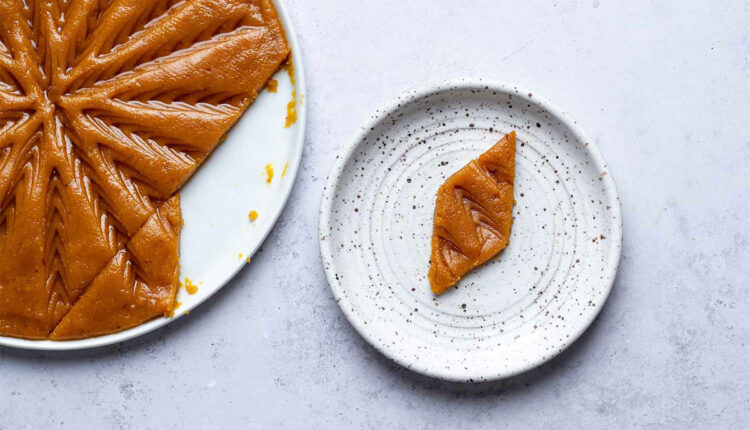© All Rights Reserved.
Persian Halva, Sweet Iranian dessert in just 3 steps
persian halva is a sweet dessert that is common in many countries. There are different types of halva, and depending on its type, sometimes it can be used as a sweet or a dessert.
In this article, on the Cookery magazine, we will learn how to cook and make Persian Halva. I hope you love it 😍
Ingredients for making Persian Halva
| Flour | 2 cups |
| Water | 1 cup |
| White Sugar | 2 cups |
| Rosewater | 1/2 cup |
| cardamom powder | 1 teaspoon |
| Saffron water | 2 tablespoons |
| Butter | 50 grams |
| Vegetable oil | 1 cup |
Recipe for making Persian Halva
The first step in making Halva syrup
For cooking Persian Halva, firstly:
- Put the water and sugar in a pot on low heat.
- After a while, stir them gently with a wooden spoon and let them come to a boil.
- Keep cooking it for about 10 minutes. The syrup will be thickened up.
- Here, turn off the heat and add one teaspoon of cardamom powder, half a cup of rose water, and two tablespoons of saffron water to give the mixture a vibrant color.
- Make sure they are well combined.
- Set it aside, and let’s prepare the flour for Halva.
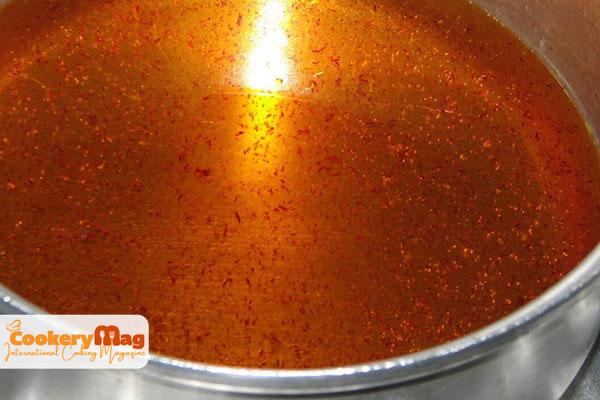
The second step; making Flour in Halva

Put a large pan on low heat. Add to cups of flour. Toast the flour and stir it for about 10 minutes. Make a small hole at the center. Then add the butter and oil. Start stirring until they’re combined. Stir for about 10 minutes, and you will notice the color starts to change.
In the end, add the syrup to the mixture and stir fast. Cook it for about 7 minutes. Your mixture will be consistent.
The third step; Serving Halva
Pour your Halva into a plate, and you can use a spoon to design it. You can garnish Halva with slivered pistachios and almonds. Also, desiccated coconut is another option for garnishing Halva.
Tell me about your experience of cooking Persian Halva.

Having a journey in the history of Persian halva
The first written recipe for Halva was in the Arabic book Kitab al-Tabikh by Ibn Sayyar al-Warraq from the early 13th century.
According to Alan Davidson of The Oxford Companion to Food, Halva is an Arabic dish. Eight different types of Halva and their recipes are mentioned in Middle Eastern culture.
Food historians believe that Halva was found around 3000 BC. As old as the hills and their roots. The word Halva is considered Arabic and has its roots in the word halwa, which means sweet food or sweet meat.
Halva is one of those foods served from the Balkans to India, and almost every culture and country considers it their own.
There are many types of halva and Persian halva. But the original halva was prepared in the Balkans and Turkey.
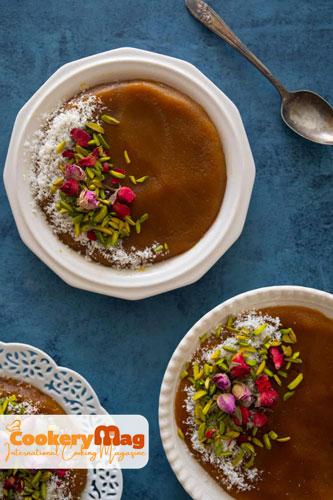
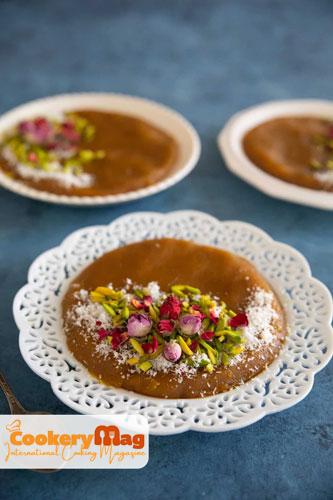
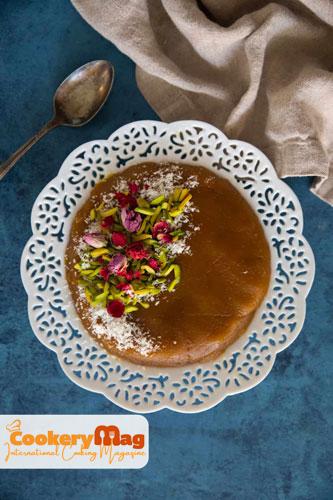
Halva is a simple dessert, and the most common of it is prepared by cooking bulgur. Of course, again, this depends on each country. For example, in Iran, the common Persian halva is prepared with wheat flour in plain and saffron.
According to other legend stories, the method of cooking halva has its roots and origins in the Ottoman Empire.
In The Turkish Cookbook, Novin Halici writes that halva – or halwa as it is called in Turkey – is the oldest dessert in Turkish cuisine.
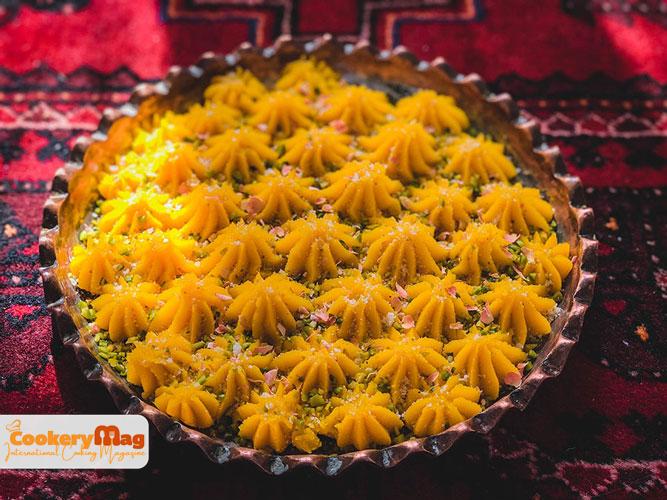
One of the most famous lovers of sweets was Suleiman the Magnificent (1566-1520), the longest reigning sultan of the Ottoman Empire, who built an exceptional kitchen called “Halvahane” (halva house) next to his palace.
Thirty types of sweets were prepared there in the halva house. Romanians adopted one made with sesame under Ottoman rule, who passed it on to Ashkenazi Jews in Europe, and it was this version that made the transatlantic journey to America in the early 20th century.
Different kinds of Persian halva

One of the souvenirs of Damavand is Halva Luz. Halva Loz is a sweet halva that is prepared without sugar.

Its taste is the same as normal halva, and the only difference is its appearance

Ardabil black halva is a very nutritious halvah with a very high shelf life and lasts for several months without refrigeration.
Black halva has a dark color and a spicy taste of pepper.

Pistachio halva is a rich and natural energy source lost during the day. This Persian halva is very useful and is considered a good source of protein. Therefore, it is an ideal option for feeding children and teenagers.
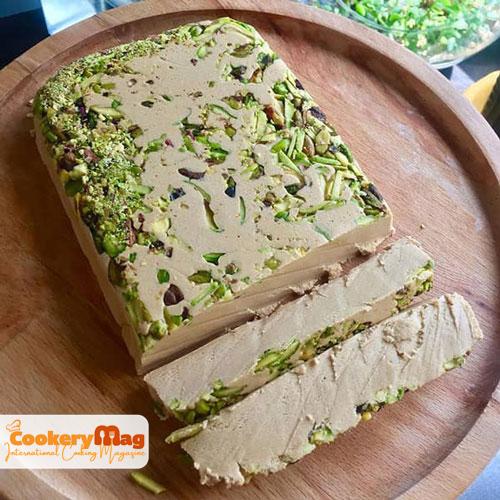
Halva arde is a creamy paste that is usually served for breakfast.

Carrot halva is one of the delicious and colorful Persian halva that is usually prepared for religious ceremonies.
Frequently Asked Questions
What is halva?
Halva is a snack that can be eaten anytime, on its own or with bread, tea, coffee, and wine.
It tastes sweet and has different textures and flavors. This depends on the additional ingredients used in it, such as peanuts, almonds, pistachios, chocolate, saffron, etc. Many people say it tastes similar to nut butter or peanut butter.
Halva, Helva, Halwa or Halvah?
This name has had a long journey, which is why it is defined as Halava in Sanskrit, Halawa in Egypt, Halvas in Greek, Halvah in Hebrew, Halwa or Halawi in Arabic, Helva in Turkey, and Halva in India.
Conclusion
Thank you again for being with us with an excellent, delicious, authentic Iranian persian halva recipe. Share your experiences with us, and if you have any tips to improve the Iranian halva recipe, be sure to comment; thank you.
And finally, I would like to thank those who took the time to read this article about Persian halva.
It is hoped that among the delicious foods of different societies, Iranian food is gaining more and more fans daily.
Please share this article with your friends on Facebook, Twitter, Pinterest, and other social media. 🧡

